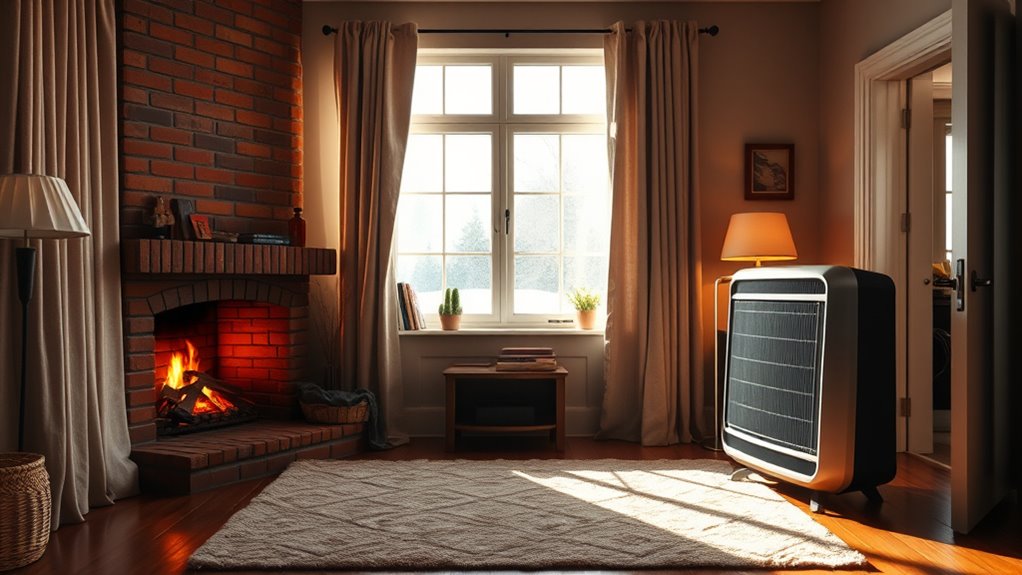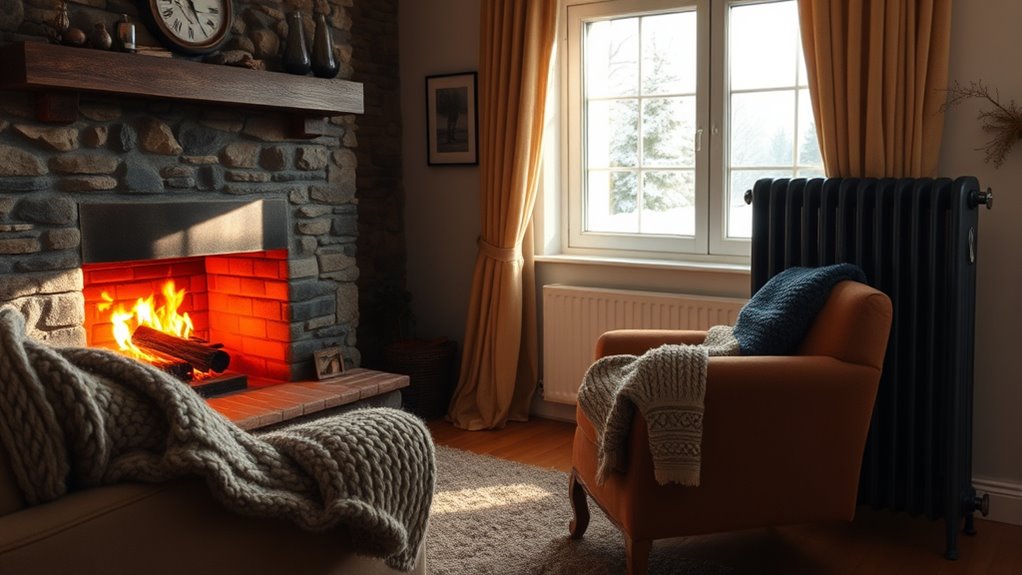To heat your home for less, start by sealing drafts around windows and doors with weatherstripping and caulking, and use door sweeps to block cold air. Maximize natural warmth by opening curtains during the day and closing them at night. Improve insulation in your attic, walls, and floors, and keep your heating system well-maintained or upgrade to a high-efficiency model. Additionally, layer your clothing and use portable heaters for comfort. Keep going to discover even more cost-saving tips!
Key Takeaways
- Seal drafts around windows, doors, and openings with weatherstripping, caulking, and door sweeps to prevent heat loss.
- Maximize natural heat by opening curtains during the day and closing them at night to retain warmth.
- Improve home insulation in attic, walls, and floors to reduce heat escape and enhance heating efficiency.
- Maintain and upgrade heating systems regularly, such as changing filters and choosing high-efficiency models.
- Use personal strategies like layering clothing and targeted portable heaters to stay warm without increasing overall energy use.

Are you looking for ways to lower your heating bills without sacrificing comfort? If so, you’re not alone. Many homeowners want to stay warm without breaking the bank, and luckily, there are effective strategies that can help you do just that. The key is to make small changes that add up over time, improving your home’s efficiency and reducing unnecessary heat loss.
First, focus on sealing drafts around windows, doors, and other openings. Even tiny gaps can let warm air escape and cold air seep in, forcing your heating system to work harder. Use weatherstripping or caulking to close those gaps. You’ll be surprised how much warmer your space feels once drafts are eliminated. Additionally, consider adding door sweeps to exterior doors and installing draft stoppers on interior doors to keep heated air from escaping into unoccupied rooms.
Next, take advantage of your home’s natural heat sources. Open curtains and blinds during the day to let sunlight warm your rooms, then close them at night to retain that heat. This simple step harnesses free solar energy and minimizes heat loss after sunset. Also, arrange furniture so that it doesn’t block radiators or vents, allowing heat to circulate freely throughout your space.
Another effective trick involves upgrading your insulation. Proper insulation in your attic, walls, and floors keeps warm air inside and cold air out. If your home is under-insulated, your heating system has to work overtime to maintain a comfortable temperature. Investing in insulation can be a game-changer, reducing your heating bills considerably over time. While it might seem like a big upfront cost, the savings on your energy bills make it worthwhile.
Furthermore, regularly maintaining your heating system ensures it runs efficiently. Change filters, bleed radiators, and schedule annual check-ups. An efficient furnace or heat pump consumes less energy and provides consistent warmth. If your system is outdated or inefficient, consider upgrading to a high-efficiency model, which can cut your heating costs substantially.
Finally, embrace the idea of layering clothing and using portable heaters or heated blankets when appropriate. These small adjustments allow you to turn down your thermostat without feeling cold. Wearing warm clothing indoors can make a noticeable difference, especially during nighttime or when you’re lounging around. Portable heaters can target specific rooms, so you don’t have to heat your entire home when only one area is in use.
In addition, using a curling iron on Halloween wigs can help you achieve stylish, long-lasting curls that enhance your costume without requiring heat styling every day, saving you energy and time.
Frequently Asked Questions
How Can I Tell if My Home Insulation Is Sufficient?
You can tell if your home insulation is sufficient by checking for drafts around windows and doors, feeling for cold spots on walls or floors, and inspecting your attic insulation level. If your energy bills are high or your home cools quickly, it’s a sign you might need more insulation. Consider hiring a professional to perform an insulation audit for an accurate assessment and personalized recommendations.
Are Programmable Thermostats Cost-Effective for Small Households?
Did you know that programmable thermostats can save you up to 10% on heating costs annually? For small households, they’re definitely cost-effective. You can set the temperature to lower during your work hours and overnight, then raise it before you wake up or return home. This automation reduces unnecessary heating, saving you money without sacrificing comfort. If you’re looking to cut costs, a programmable thermostat is a smart, efficient choice.
What Are the Best Low-Cost Ways to Seal Drafts?
You can seal drafts cheaply by using weatherstripping around doors and windows, which blocks unwanted air leaks. Applying draft stoppers or rolled-up towels at door bottoms also helps, especially during cold nights. Caulking gaps and cracks with inexpensive sealant is effective for stationary areas. Additionally, covering vents or unused chimneys with draft stoppers keeps cold air out. These simple, low-cost steps markedly improve your home’s insulation without breaking the bank.
How Often Should I Service My Heating System?
You should service your heating system once a year, ideally before the cold weather hits. Imagine your furnace as a well-tuned engine, humming smoothly when it’s in top shape. During servicing, a technician cleans filters, checks for leaks, and guarantees all parts work efficiently. Regular maintenance keeps your system running reliably, reduces energy bills, and extends its lifespan. Schedule your annual tune-up now to stay cozy all winter long.
Can Solar Heating Systems Really Reduce My Energy Bills?
Yes, solar heating systems can considerably reduce your energy bills. They harness the sun’s free energy to heat your home, decreasing your reliance on conventional power sources. While upfront costs are higher, you’ll save money in the long run through lower utility bills. Plus, solar systems are eco-friendly, reducing your carbon footprint. With proper installation and maintenance, solar heating becomes an efficient, sustainable way to keep your home warm and save money.
Conclusion
By applying these simple tricks, you could cut your heating costs substantially. Did you know that sealing drafts alone can save you up to 15% on heating bills? Small changes, like adding weatherstripping or using a programmable thermostat, make a big difference. Keep these tips in mind, and you’ll stay warm without overspending. Heating smarter not only saves money but also keeps your home cozy all season long.









